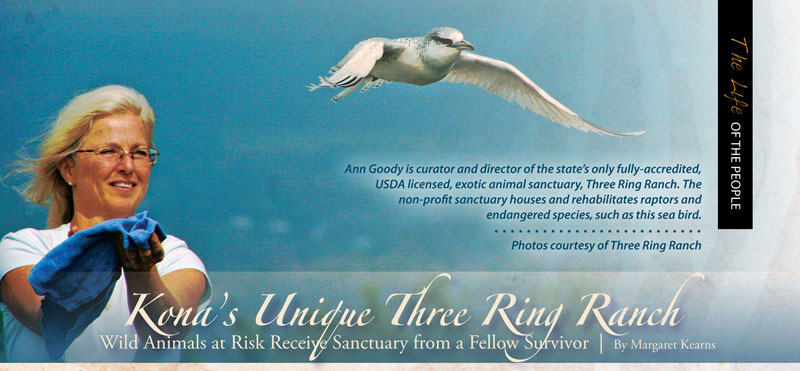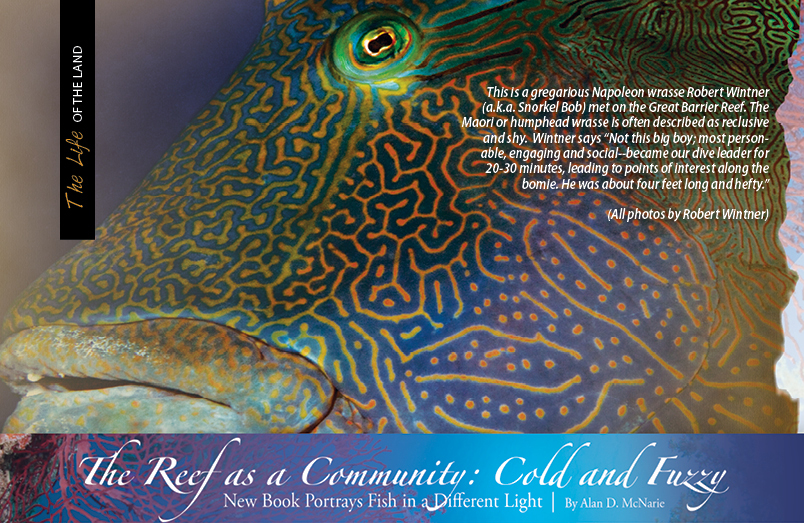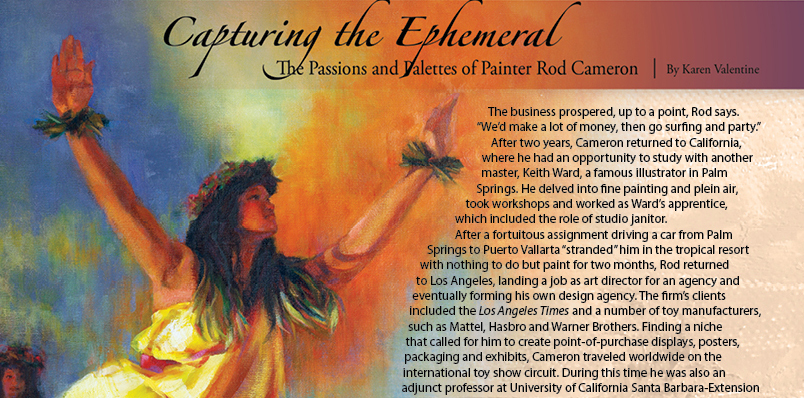
Kona’s Unique Three Ring Ranch: Wild Animals at Risk Receive Sanctuary from a Fellow Survivor

By Margaret Kearns
Sometimes it takes a few wake-up calls before setting out on an intended life path. For California native, Ann Goody, it was an amazing series of events—a combination of both incredible luck and disastrous, near-death experiences—that redirected her from her pursuit of a career in nursing to becoming founder and curator of Hawai‘i Island’s Three Ring Ranch Animal Sanctuary.
“In 1994 I was living in Bear Valley when a stop at McDonald’s resulted in a trip to Hawai‘i Island…it was one of those ‘peel-and-peek-to-see-if-you-win’ contests. I did and I won,” she said. “I loved the island and five months after my return from that trip, I entered another contest, an essay this time, and won again. The incentive (another trip to the Big Island) was huge! I packed my bags, flew to Hawai‘i and never left.”
Luck and lots of love continued smiling on Goody during her early years here. While working in health administration and preparing her dissertation for a doctorate degree in Philosophy of Health Service Management, she met anesthesiologist Dr. Norm Goody and within just a week had agreed to marry him.
The first of what Goody calls her “idiot slaps,” however, was lurking just beyond the couple’s wedding day.
“In June 1997, the day after our wedding reception, I was struck by lightning. Literally a slap in the face, it struck my right cheek and exited through the bottom of my left foot, cooking way too many things on its way out,” she said.
Tough, optimistic and the ultimate survivor, Goody fought to recover, but just three months into her year-long convalescence she suffered another, nearly-fatal blow. Snorkeling with Norm near Miloli’i, she suddenly found herself prey for a large tiger shark. Hit hard and tossed high into the air, she was shaken but not bitten, as witnesses on the beach watched amazed that she had not been killed or severely injured.
Luck aside, her year-long recovery from the lightning strike was anything but easy and some days were much more difficult than others. On one of those especially brutal days, Norm asked what he could do to make things a bit better for her. She jokingly replied, “A zebra would be nice.”
Norm wasn’t laughing and he certainly wasn’t joking about doing whatever it took to help Ann through her dark days. Once again, luck stepped in. Among hundreds of animals requiring relocation due to the then-imminent closure of the Molokai Ranch Safari Park was Oreo, a pregnant zebra. After the arduous task of securing state and federal permits, the couple brought Oreo, her newborn filly, Zoe (a rare, blond zebra believed to be the only one of its kind existing in the world today), two oryx and Frazier, a South African crowned crane, to their five-acre home situated above Kailua-Kona. These five animals, including Oreo and her million-dollar baby Zoe (blond zebras are estimated to occur only once in three million births and don’t survive in the wild since their coloring makes them easy targets for predators) were the real founders of Three Ring Ranch Animal Sanctuary, according to Ann Goody.
And while that may be true, it was her childhood passion for working with wildlife in California’s San Fernando Valley and the hours she logged volunteering with the Bureau of Land Management and the U.S. Fish and Wildlife Agency that led to Ann Goody’s present status: a federally permitted wildlife rehabilitation expert who earned the permits required to begin operating the sanctuary here in 1998.
Now in its second decade with more than 130 ‘critters’ in its care, Three Ring Ranch Animal Sanctuary provides animal rescue, rehabilitation, and in some cases, a forever home for native and exotic species found throughout the Hawaiian Islands. The state’s only fully-accredited, USDA licensed, exotic animal sanctuary, Three Ring Ranch is a private, non-profit animal facility. It also holds state and federal wildlife permits that allow it to house and rehabilitate raptors and endangered species.
Over the years, curator Ann completed her dissertation and earned her doctorate degree in 2001. With husband Norm and a team of devoted volunteers, she has cared for creatures large and small—from newborn nene chicks, Hawaiian hawks and goats to giant land tortoises and, of course, zebras and oryx among other exotic creatures. Many of these animals were formerly located at zoos, such as the Molokai Ranch Safari Park, or big game hunting reserves in the state.
“Native animals brought to us with injuries are cared for and released whenever possible. Those unable to return to the wild (non-native species or those native species too severely injured or ill to survive) enter our resident animal population, where they live out their natural lives at the sanctuary,” she says.
And now, a few of the most recent arrivals are providing time for a bit of monkey business amidst all of the serious work being completed at Three Ring Ranch. In late 2010, Goody said, the ranch was contacted by a Hilo resident who, due to health concerns, could no longer care for her three pet monkeys—one capuchin, one Java macaque and one rhesus-Java macaque hybrid.
While monkeys are among the many animal species banned from entering the state, Goody explained that the woman had acquired the monkeys prior to the prohibitive regulation and was able to keep them as part of the state’s “grandfathered-in” provisions. The frisky trio is among the growing population of permanent residents, she said, and has already provided a challenge for participants in one of the sanctuary’s school programs. Educational programs are open to students attending public and private institutions, as well as to those being home-schooled. Ann affectionately calls the young students her “baby chicks.”
“The nickname is a term of endearment I use for these kids since they spend a lot of their time here following me around learning the proper handling and care of the different animals,” Goody said. “In this specific case, it was my ‘baby chicks’ who were taking part in the facility’s After-School Mentoring Program and were tasked with brainstorming ideas to keep the monkeys active and happy in their natural, outdoor enclosure. For the monkeys’ new living space, the kids participated in everything from initial planning and design of the enclosure to contributing ideas on what accessories would make the most positive and fun environment for the monkeys—trees, swings, rope-and-ladder suspension bridges among them.”
Another beloved recent addition to the sanctuary’s resident population is Cody, a six- month-old North American bison calf that Goody bottle-feeds several times daily. After years of waiting, Goody said, the Hokukano Ranch in Konawaena gifted Cody to the sanctuary early this year. Goody is convinced Cody will be a star teaching animal for both the formal school programs and the educational excursions offered by appointment to the general public.
“The bison is such a unique species, one that was nearly extinct not long ago,” Goody said. “Cody has lots to teach us, including the importance of protecting and nurturing all of our natural resources.”
While for Goody the sanctuary is a last stop on a career path littered with chance and near tragedy, its stated mission is: “To positively impact the environment while educating Hawai‘i’s children about their place in the natural world. The goal is to assist in the development of an environmentally responsible generation of youth. We teach about the fragile ecosystem we impact on a daily basis, while giving students and visitors a rare chance to view the animals up close.”
Among its many efforts to “positively impact the environment,” Three Ring Ranch serves as a state-designated amnesty station. Non-native species, potentially destructive to the islands’ natural flora and fauna, may be dropped at the sanctuary “no questions asked,” according to Goody. “We immediately report to the Department of Agriculture any alien species we discover or that is delivered to us and follow its precise direction in the placement of the animal in a mainland location. However, no one delivering one of these animals to us will be reported to authorities.”
“It’s an unfortunate reality that exotic animals are entering the state illegally nearly daily. Some are seized by local authorities and need permanent placement or temporary sanctuary while awaiting transport to a more appropriate, out-of-state location and that’s where we step in,” Goody said. Others, she noted, slip by regulators and enter the state undetected. “Exotic animals have complex needs, so for the animals’ welfare (and to avoid criminal penalties) we encourage people to call us if they have or know about anyone possessing an alien or exotic species.”
And that’s just one of many opportunities individuals have to help out, she said.
“Island residents and visitors are our best eyes and ears. When you’re out and about enjoying the islands, contact us immediately at 808.331.8778 should you come across injured or sick animals on the side of a road, a trail, or along the shore,” she said with this added caution: “Take care not to approach or attempt to assist, as it could be dangerous for you and the animal.”
Goody says she and her team receive hundreds of calls each month from individuals here on Hawai‘i Island and throughout the state. Fortunately, in many cases, it proves to be a false alarm. “Often good-intentioned individuals phone with concerns about green sea turtles or the occasional monk seal being stranded on the beach. After a few questions, we explain these sea critters are simply snoozing before returning to their ocean home!”
Often, however, it is a true emergency, she said, and we work closely with the individuals, asking that they stand by and observe the injured animal, sea mammal or bird, tracking its movement until our team or the appropriate wildlife agency is able to arrive on scene. Goody stressed: if in doubt, contact us. “We welcome the calls—emergency or not.”
While the sanctuary is not open to the public, private educational excursions are offered by appointment to small groups (limited to 12 maximum). The excursions are about two hours in length with a minimum suggested donation of $35 per person. Proceeds from all donations are used in the care and feeding of the animals; contributions are tax-deductible, as the sanctuary is a 501(c)3 non-profit facility.
For more information, 808.331.8778
Photos by Jenna Roussy


